Augmentation-Adapted Retriever Improves Generalization of Language Models as Generic Plug-In
增强适配检索器作为通用插件提升语言模型的泛化能力
Zichun $\mathbf{Y}\mathbf{u}^{1}$ Chenyan Xiong2 Shi $\mathbf{Y}\mathbf{u}^{1}$ Zhiyuan Liu13
Zichun $\mathbf{Y}\mathbf{u}^{1}$ Chenyan Xiong2 Shi $\mathbf{Y}\mathbf{u}^{1}$ Zhiyuan Liu13
1Dept. of Comp. Sci. & Tech., Institute for AI, Tsinghua University, Beijing, China 2Microsoft Research, Redmond, USA 3Beijing National Research Center for Information Science and Technology, Beijing, China {yuzc19, yus21}@mails.tsinghua.edu.cn; chenyan.xiong@microsoft.com liuzy@tsinghua.edu.cn
1清华大学计算机科学与技术系,人工智能研究院,中国北京 2微软研究院,美国雷德蒙 3北京信息科学与技术国家研究中心,中国北京 {yuzc19, yus21}@mails.tsinghua.edu.cn; chenyan.xiong@microsoft.com liuzy@tsinghua.edu.cn
Abstract
摘要
Retrieval augmentation can aid language models (LMs) in knowledge-intensive tasks by supplying them with external information. Prior works on retrieval augmentation usually jointly fine-tune the retriever and the LM, making them closely coupled. In this paper, we explore the scheme of generic retrieval plug-in: the retriever is to assist target LMs that may not be known beforehand or are unable to be fine-tuned together. To retrieve useful documents for unseen target LMs, we propose augmentation-adapted retriever (AAR), which learns LM’s preferences obtained from a known source LM. Experiments on the MMLU and PopQA datasets demonstrate that our AAR trained with a small source LM is able to significantly improve the zero-shot generalization of larger target LMs ranging from 250M Flan-T5 to 175B Instruct GP T. Further analysis indicates that the preferences of different LMs overlap, enabling AAR trained with a single source LM to serve as a generic plug-in for various target LMs. Our code is open-sourced at https://github.com/OpenMatch/AugmentationAdapted-Retriever.
检索增强能够通过提供外部信息,辅助语言模型(LM)完成知识密集型任务。现有检索增强研究通常联合微调检索器与语言模型,导致二者紧密耦合。本文探索通用检索插件的实现方案:检索器需辅助可能预先未知或无法联合微调的目标语言模型。为给未知目标语言模型检索有效文档,我们提出适配增强的检索器(AAR),通过学习已知源语言模型获得的偏好来优化检索。在MMLU和PopQA数据集上的实验表明,使用小型源语言模型训练的AAR能显著提升250M参数Flan-T5至175B参数InstructGPT等不同规模目标模型的零样本泛化能力。进一步分析表明,不同语言模型的偏好存在重叠,使得基于单一源模型训练的AAR可作为通用插件服务于各类目标模型。代码已开源:https://github.com/OpenMatch/AugmentationAdapted-Retriever。
1 Introduction
1 引言
Large language models (LMs) that possess billions of parameters are able to capture a significant amount of human knowledge, leading to consistent improvements on various downstream tasks (Brown et al., 2020; Kaplan et al., 2020; Roberts et al., 2020). However, the undeniable drawback of large LMs lies in their high computational cost, which negatively impacts their efficiency (Strubell et al., 2019; Bender et al., 2021). Furthermore, the knowledge memorized from pretraining and the implicit reasoning process of LMs can be inaccurate and intractable sometimes, hindering their applications on knowledge-intensive tasks (Guu et al., 2020; Lewis et al., 2020; Mallen et al., 2022; Wei et al., 2022).
拥有数十亿参数的大语言模型(LM)能够捕获大量人类知识,从而在各种下游任务上持续取得进步 (Brown et al., 2020; Kaplan et al., 2020; Roberts et al., 2020)。然而,大语言模型不可否认的缺点在于其高昂的计算成本,这会影响其效率 (Strubell et al., 2019; Bender et al., 2021)。此外,从预训练中记忆的知识和语言模型的隐式推理过程有时可能不准确且难以处理,阻碍了其在知识密集型任务中的应用 (Guu et al., 2020; Lewis et al., 2020; Mallen et al., 2022; Wei et al., 2022)。
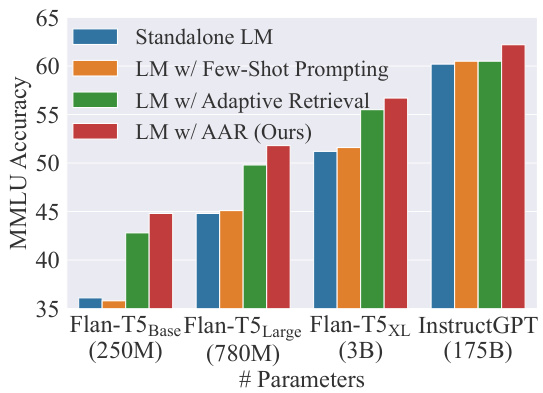
Figure 1: Performance of LM w/ AAR (Ours).
图 1: 采用AAR的LM性能(本研究)。
Instead of leveraging the knowledge and reasoning abilities embedded within the parameters of the LMs, retrieval augmentation (Guu et al., 2020; Lewis et al., 2020; Borgeaud et al., 2022) enhances the LM with a retriever that can retrieve knowledge from an external corpus. On the other hand, prior retrieval augmentation methods (Izacard and Grave, 2021a; Izacard et al., 2022) necessitate fine-tuning the backbone LM to adjust to the retriever and tackle specific downstream tasks. This kind of fine-tuning can be expensive when more and more unique demands emerge (Maro nikola k is and Schütze, 2021). More importantly, many toptier LMs can only be accessed through black-box APIs (Ouyang et al., 2022; OpenAI, 2023). These APIs allow users to submit queries and receive responses but typically do not support fine-tuning.
检索增强 (retrieval augmentation) (Guu et al., 2020; Lewis et al., 2020; Borgeaud et al., 2022) 并非利用大语言模型参数中内嵌的知识与推理能力,而是通过检索器从外部语料库获取知识来增强模型性能。另一方面,现有检索增强方法 (Izacard and Grave, 2021a; Izacard et al., 2022) 需要对骨干大语言模型进行微调以适应检索器并处理特定下游任务。当出现越来越多独特需求时 (Maro nikola k is and Schütze, 2021),此类微调成本会变得高昂。更重要的是,许多顶级大语言模型仅能通过黑盒API访问 (Ouyang et al., 2022; OpenAI, 2023),这些API允许用户提交查询并获取响应,但通常不支持微调。
In this paper, we introduce AugmentationAdapted Retriever (AAR) to assist black-box LMs with downstream tasks as generic plug-in. To retrieve valuable documents for many unseen LMs, we propose to leverage a small source LM to provide LM-preferred signals for retriever’s training. The retriever after training (i.e., AAR) can be directly utilized to assist a large target LM by plugging in the retrieved documents.
本文介绍了增强适应检索器 (AugmentationAdapted Retriever, AAR) ,作为通用插件协助黑盒大语言模型完成下游任务。为了为众多未见过的模型检索有价值文档,我们提出利用一个小型源模型提供模型偏好的信号来训练检索器。训练后的检索器 (即AAR) 可直接通过插入检索到的文档来辅助大型目标模型。
Specifically, we choose a small encoder-decoder LM as the source LM and utilize its fusionin-decoder attention scores (Izacard and Grave, 2021a) to annotate LM-preferred documents. The LM-preferred documents are then combined with human-preferred documents to form the positive document set. Negative documents are mined by the retriever itself using the ANCE (Xiong et al., 2021) technique. After fine-tuning the retriever with LM’s preferences, it can directly assist unseen target LMs in the zero-shot task generalization.
具体来说,我们选择一个小型编码器-解码器大语言模型作为源模型,并利用其解码器融合注意力分数 (Izacard and Grave, 2021a) 来标注模型偏好的文档。这些模型偏好的文档随后与人类偏好的文档结合,形成正例文档集。负例文档则通过检索器自身使用ANCE技术 (Xiong et al., 2021) 进行挖掘。在用模型的偏好微调检索器后,它可以直接在零样本任务泛化中协助未见过的目标大语言模型。
We evaluate AAR on a multi-task language understanding dataset MMLU (Hendrycks et al., 2021) and an entity-centric question answering dataset PopQA (Mallen et al., 2022). For the target LMs, we choose Flan-T5 (Chung et al., 2022) series as our backbone for encoder-decoder LMs and Instruct GP T (Ouyang et al., 2022) as our backbone for decoder-only LMs. Figure 1 shows that assisted with a generic AAR, LMs of different sizes and architectures can consistently outperform the standalone LMs; the performance of smaller LMs can sometimes surpass the standalone counterparts of significantly larger sizes (e.g., Flan-T5Large w/ AAR outperforms standalone Flan $.\mathrm{T}5_{\mathrm{XL}}$ by $0.6%$ ). AAR also demonstrates advantages over other augmentation approaches such as few-shot prompting and adaptive retrieval (Mallen et al., 2022).
我们在多任务语言理解数据集MMLU (Hendrycks et al., 2021) 和以实体为中心的问答数据集PopQA (Mallen et al., 2022) 上评估AAR。对于目标大语言模型,我们选择Flan-T5 (Chung et al., 2022) 系列作为编码器-解码器架构的基准模型,并选用Instruct GPT (Ouyang et al., 2022) 作为纯解码器架构的基准模型。图1显示,在通用AAR的辅助下,不同规模和架构的大语言模型都能持续超越独立运行的大语言模型;较小模型的性能有时甚至能显著超越规模大得多的独立运行模型 (例如配备AAR的Flan-T5Large比独立运行的Flan-T5XL高出0.6%)。AAR也展现出相对于少样本提示 (few-shot prompting) 和自适应检索 (adaptive retrieval) (Mallen et al., 2022)) 等其他增强方法的优势。
Further analysis reveals that the preferences obtained from different-sized source LMs are similar, and LMs with near capacities tend to yield closer preferred document sets. As a result, our AAR model trained from a small source LM can be considered as a generic plug-in to enhance the zeroshot generalization of a significantly larger target LM. We also discover that the documents preferred by LMs can provide assistance to the model from alternative perspectives, rather than relying solely on the full information favored by search users.
进一步分析表明,不同规模源大语言模型获得的偏好具有相似性,且容量相近的模型往往会产生更接近的偏好文档集。因此,我们基于小型源大语言模型训练的AAR模型,可作为通用插件来显著增强大型目标大语言模型的零样本泛化能力。研究还发现,大语言模型偏好的文档能从替代视角为模型提供辅助,而非仅依赖搜索用户青睐的完整信息。
2 Related Work
2 相关工作
Retrieval Augmentation. Augmenting LMs with retrieved information from external memories has shown effective on diverse knowledge-intensive tasks (Guu et al., 2020). Prior works explore novel ways to train the whole retriever-LM system in an end-to-end fashion, using retrievalaugmented sequence log-likelihood (Lewis et al., 2020; Borgeaud et al., 2022), fusion-in-decoder attention distillation (Izacard and Grave, 2021a; Izacard et al., 2022), or knowledge graph (Ju et al., 2022). To decouple the retriever from LM, Rubin et al. (2022) train an independent prompt retriever for in-context learning, and Lin et al. (2022) only fine-tune the LM via the retrieved data that is similar to few-shot unsupervised samples.
检索增强 (Retrieval Augmentation)。通过从外部记忆库中检索信息来增强大语言模型,已在多种知识密集型任务中展现出有效性 (Guu et al., 2020)。先前研究探索了端到端训练整个检索器-语言模型系统的新方法,包括使用检索增强序列对数似然 (Lewis et al., 2020; Borgeaud et al., 2022)、解码器融合注意力蒸馏 (Izacard and Grave, 2021a; Izacard et al., 2022) 或知识图谱 (Ju et al., 2022)。为解耦检索器与语言模型,Rubin et al. (2022) 训练了独立的提示检索器用于上下文学习,而 Lin et al. (2022) 仅通过类似于少样本无监督样本的检索数据对语言模型进行微调。
Recent researches adopt zero-shot retrieval augmentation that does not fine-tune the LM on InstructGPT (Ouyang et al., 2022). It can benefit entity-centric question answering (Mallen et al., 2022), chain-of-thought reasoning (He et al., 2022), and multi-hop question answering (Khattab et al., 2022). Parallel work (Shi et al., 2023) uses LM likelihood to train the retriever for satisfying blackbox LM’s preferences, and they adopt GPT-3 Curie (Brown et al., 2020) to provide the supervision signals. In this work, we devise the retriever that can be used as a generic plug-in to assist a variety of unseen LMs.
近期研究采用零样本检索增强技术,该技术无需在InstructGPT (Ouyang等人,2022) 上对语言模型进行微调。这种方法可提升以实体为中心的问答 (Mallen等人,2022) 、思维链推理 (He等人,2022) 以及多跳问答 (Khattab等人,2022) 的效果。并行研究 (Shi等人,2023) 利用语言模型似然性训练检索器以满足黑盒语言模型的偏好,并采用GPT-3 Curie (Brown等人,2020) 提供监督信号。本工作设计的检索器可作为通用插件辅助各类未知语言模型。
Zero-shot Learning and Reasoning. Largescale unsupervised pre-trained LMs like GPT3 (Brown et al., 2020), GPT-4 (OpenAI, 2023), and PaLM (Chowdhery et al., 2022) are able to perform zero-shot learning on many downstream tasks with a task description provided at inference time. Instruction-finetuned LMs (Sanh et al., 2022; Chung et al., 2022; Ouyang et al., 2022), which are pre-trained on multiple supervised tasks using human instructions, also also exhibit robust zeroshot learning capabilities. Yu et al. (2023) propose a new scheme of zero-shot reasoning, which first prompts large LMs to generate relevant documents and then perform reading comprehension on the generated contents. Recently, there has been a growing trend of utilizing plug-and-play knowledge injection to enhance the zero-shot performance of LMs, which is achieved through mapping network (Zhang et al., 2023) or document encoding (Xiao et al., 2023). Our work improves the zero-shot generalization of LMs by utilizing the retrieved information. We demonstrate that identifying LMs’ preferences to train the retriever can in turn bring additional evidence texts for LMs.
零样本学习与推理。像GPT-3 (Brown等人,2020)、GPT-4 (OpenAI,2023) 和PaLM (Chowdhery等人,2022) 这样的大规模无监督预训练大语言模型,能够在推理时通过任务描述对许多下游任务进行零样本学习。基于指令微调的大语言模型 (Sanh等人,2022;Chung等人,2022;Ouyang等人,2022) 通过人类指令对多个监督任务进行预训练后,同样展现出强大的零样本学习能力。Yu等人 (2023) 提出了一种新的零样本推理方案,先提示大语言模型生成相关文档,再对生成内容进行阅读理解。近期,越来越多研究通过即插即用的知识注入来增强大语言模型的零样本性能,具体实现方式包括映射网络 (Zhang等人,2023) 或文档编码 (Xiao等人,2023)。我们的工作通过利用检索信息提升了大语言模型的零样本泛化能力。实验表明,通过识别大语言模型的偏好来训练检索器,能够为其提供额外的证据文本。
3 Method
3 方法
In this section, we first introduce the preliminaries of the dense retrieval and the retrieval-augmented LM $(\S\enspace3.1)$ , then propose our augmentationadapted retriever $(\S3.2)$ .
在本节中,我们首先介绍密集检索 (dense retrieval) 和检索增强语言模型 (retrieval-augmented LM) 的基础知识 (第3.1节),然后提出我们的自适应增强检索器 (第3.2节)。
3.1 Preliminaries
3.1 预备知识
Retrieval-augmented LM (Guu et al., 2020; Lewis et al., 2020) is a type of LM that leverages external information to improve its performance. It retrieves relevant documents from a corpus using a retriever, and then utilizes the documents to enhance its language generation capabilities.
检索增强型大语言模型 (Retrieval-augmented LM) (Guu et al., 2020; Lewis et al., 2020) 是一种利用外部信息提升性能的大语言模型。它通过检索器从语料库中获取相关文档,并利用这些文档来增强其语言生成能力。
The objective of the retriever is to find an augmentation document set $D^{a}$ from a corpus $C$ that helps the LM handle a given query $q$ . Previous researches (Karpukhin et al., 2020; Xiong et al., 2021) concentrate primarily on the dense retrieval system that searches in the dense vector space since dense retrieval usually performs more accurately and efficiently than sparse one.
检索器的目标是从语料库 $C$ 中找到一个有助于大语言模型处理给定查询 $q$ 的增强文档集 $D^{a}$。先前的研究 [20][21] 主要集中于在稠密向量空间中进行搜索的稠密检索系统,因为稠密检索通常比稀疏检索更准确高效。
A dense retrieval model first represents $q$ and the document $d$ into an embedding space using a pre-trained encoder $g$ ,
密集检索模型首先使用预训练的编码器 $g$ 将查询 $q$ 和文档 $d$ 映射到嵌入空间,
$$
\pmb{q}=q(q);\pmb{d}=g(d),d\in C,
$$
$$
\pmb{q}=q(q);\pmb{d}=g(d),d\in C,
$$
and match their embeddings by dot product function $f$ , which supports fast approximate nearest neighbor search (ANN) (André et al., 2016; Johnson et al., 2021). We then define $D^{a}$ that contains top $N$ retrieved documents as:
并通过点积函数 $f$ 匹配它们的嵌入向量,支持快速近似最近邻搜索 (ANN) (André et al., 2016; Johnson et al., 2021)。随后我们将包含前 $N$ 个检索文档的集合定义为 $D^{a}$:
$$
D^{a}={d_{1}^{a}...d_{N}^{a}}=\mathrm{ANN}_{f(q,\circ)}^{N}.
$$
$$
D^{a}={d_{1}^{a}...d_{N}^{a}}=\mathrm{ANN}_{f(q,\circ)}^{N}.
$$
For the LM backbones, the decoder-only and the encoder-decoder models are the two primary choices of the retrieval-augmented LMs (Izacard and Grave, 2021b; Yu et al., 2023).
在检索增强的大语言模型架构选择上,主要存在两种核心范式:仅解码器(decoder-only)模型和编码器-解码器(encoder-decoder)模型 (Izacard and Grave, 2021b; Yu et al., 2023)。
Given a decoder-only LM like GPT-3 (Brown et al., 2020), the LM input can be a simple concatenation of the query and all the augmentation documents ${d_{1}^{a}\cdot\cdot\cdot d_{N}^{a}}$ . Then, the LM will generate the answer based on the inputs auto-regressive ly.
给定一个仅解码器的大语言模型(如GPT-3 [20]),模型输入可以是查询与所有增强文档${d_{1}^{a}\cdot\cdot\cdot d_{N}^{a}}$的简单拼接。随后,该模型将以自回归方式基于输入生成答案。
For an encoder-decoder LM like T5 (Raffel et al., 2020), taking simple concatenation as the encoder input may still be effective. However, this method may not scale to a large volume of documents due to the quadratic self-attention computation associated with the number of documents. To aggregate multiple documents more efficiently, Izacard and Grave (2021b) propose the fusion-in-decoder (FiD) mechanism, which soon becomes the mainstream in the development of encoder-decoder retrievalaugmented LMs. It first encodes each concatenation of the $(d_{i}^{a},q)$ pair separately and then lets the decoder attend to all parts:
对于像T5 (Raffel et al., 2020) 这样的编码器-解码器大语言模型,采用简单拼接作为编码器输入可能仍然有效。但由于文档数量会导致自注意力计算呈平方级增长,这种方法难以扩展到海量文档场景。为更高效聚合多文档,Izacard和Grave (2021b) 提出了解码器融合 (FiD) 机制,该方案迅速成为编码器-解码器检索增强大语言模型开发的主流范式。其核心是先将每个$(d_{i}^{a},q)$ 对分别编码,再让解码器关注所有片段:
$$
\mathrm{FiD}(q)=\mathrm{Dec}(\mathrm{Enc}(d_{1}^{a}\oplus q)\cdot\cdot\cdot\mathrm{Enc}(d_{N}^{a}\oplus q)).
$$
$$
\mathrm{FiD}(q)=\mathrm{Dec}(\mathrm{Enc}(d_{1}^{a}\oplus q)\cdot\cdot\cdot\mathrm{Enc}(d_{N}^{a}\oplus q)).
$$
In this way, the encoder computes self-attention over one document at a time so that the computational cost can grow linearly with the number of documents. Furthermore, FiD cross-attention is found effective in estimating the relative importance of the augmentation documents from the LM’s perspective (Izacard and Grave, 2021a). Therefore, soft FiD distillation (Izacard and Grave, 2021a; Izacard et al., 2022; Shi et al., 2023), which minimizes the KL-divergence between retrieval likelihood and LM likelihood, is often used to train the retriever and the LM end-to-end.
通过这种方式,编码器每次仅计算单个文档的自注意力(self-attention),使得计算成本随文档数量线性增长。此外,研究发现FiD交叉注意力(FiD cross-attention)能有效评估增强文档在大语言模型视角下的相对重要性(Izacard and Grave, 2021a)。因此,通常采用软FiD蒸馏(soft FiD distillation)(Izacard and Grave, 2021a; Izacard et al., 2022; Shi et al., 2023)来端到端训练检索器与大语言模型,该方法通过最小化检索似然与语言模型似然之间的KL散度实现。
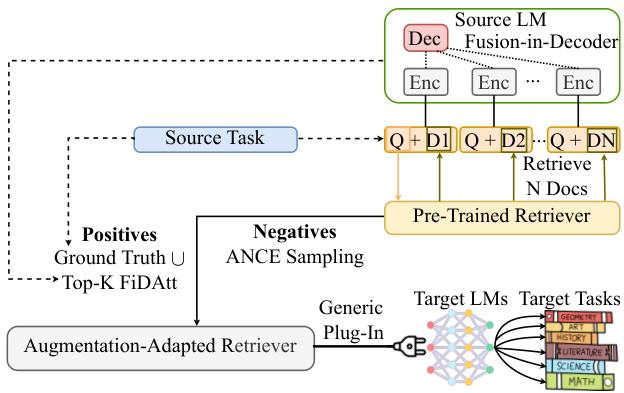
Figure 2: Illustration of augmentation-adapted retriever.
图 2: 增强适配检索器示意图。
3.2 Augmentation-adapted Retriever
3.2 适应增强的检索器
Due to the emerging real-world demands and the limitations of black-box APIs, fine-tuning retrieval-augmented LM for each possible downstream task can be infeasible. Hence, we introduce Augmentation-Adapted Retriever (AAR) as a generic plug-in for black-box LMs. As illustrated in Figure 2, AAR can learn the preferences of LMs without the need for fine-tuning them.
由于现实需求不断涌现以及黑盒API的局限性,为每个潜在的下游任务微调检索增强的大语言模型可能并不可行。因此,我们引入了适配增强的检索器 (AAR) 作为黑盒大语言模型的通用插件。如图 2 所示,AAR 无需微调即可学习大语言模型的偏好。
Specifically, we utilize an encoder-decoder LM as source LM $(L_{s})$ to provide LM-preferred signals on a source task $(T_{s})$ for fine-tuning a pre-trained retriever. Then, we plug the fine-tuned retriever into unseen target LM $(L_{t})$ on a set of target tasks $(T_{t})$ non-intersecting with $T_{s}$ .
具体而言,我们采用编码器-解码器架构的大语言模型作为源模型 $(L_{s})$ ,通过在源任务 $(T_{s})$ 上提供模型偏好信号来微调预训练的检索器。随后,我们将微调后的检索器部署到未见过的目标模型 $(L_{t})$ 上,用于处理与 $T_{s}$ 不相交的一系列目标任务 $(T_{t})$ 。
Our training method starts from a source task $T_{s}$ , where we aggregate the source LM $L_{s}$ ’s average FiD cross-attention (FiDAtt) scores $S_{i}^{a}$ corresponding to document $d_{i}^{a}$ from the first decoder token over all the layers, all the heads and all the input tokens $t$ of $d_{i}^{a}\oplus q$ :
我们的训练方法从一个源任务 $T_{s}$ 开始,在此我们聚合源大语言模型 $L_{s}$ 的平均FiD交叉注意力(FiDAtt)分数 $S_{i}^{a}$,这些分数对应于文档 $d_{i}^{a}$,来自所有层、所有注意力头以及 $d_{i}^{a}\oplus q$ 的所有输入token $t$ 的第一个解码器token:
$$
S_{i}^{a}=\frac{1}{\ln*\ln*\tan}\sum_{\mathrm{layers}}\sum_{\mathrm{heads}}\sum_{{t}\in d_{i}^{a}\oplus{q}}\mathrm{FiDAtt}(\mathrm{FiD}(q)).
$$
$$
S_{i}^{a}=\frac{1}{\ln*\ln*\tan}\sum_{\mathrm{layers}}\sum_{\mathrm{heads}}\sum_{{t}\in d_{i}^{a}\oplus{q}}\mathrm{FiDAtt}(\mathrm{FiD}(q)).
$$
where ln, hn, tn are the numbers of the layers, the heads and the input tokens.
其中 ln、hn、tn 分别表示层数、头数和输入 token 数。
To make the training process more robust, we utilize the FiDAtt scores to annotate the LM-preferred positive documents in a discrete way:
为了使训练过程更加稳健,我们利用FiDAtt分数以离散方式标注LM偏好的正向文档:
$$
D^{a+}=D^{h+}\cup\mathrm{Top}{-}K_{S_{i}^{a},D^{a}},
$$
$$
D^{a+}=D^{h+}\cup\mathrm{Top}{-}K_{S_{i}^{a},D^{a}},
$$
where $D^{h+}$ is the human-preferred positive document set (i.e., ground truth) on $T_{s}$ . Top $K_{S_{i}^{a},D^{a}}$ means the documents with the top $\mathbf{\nabla\cdot}\mathbf{k}$ average FiDAtt scores $S_{i}^{a}$ in the retrieved document set $D^{a}$ .
其中 $D^{h+}$ 是 $T_{s}$ 上人类偏好的正文档集(即真实值)。Top $K_{S_{i}^{a},D^{a}}$ 表示在检索文档集 $D^{a}$ 中具有前 $\mathbf{\nabla\cdot}\mathbf{k}$ 平均FiDAtt分数 $S_{i}^{a}$ 的文档。
Then, we sample hard negatives following ANCE (Xiong et al., 2021) and formulate the training loss $\mathcal{L}$ of the retriever as:
然后,我们按照ANCE (Xiong et al., 2021)的方法采样困难负例,并将检索器的训练损失$\mathcal{L}$表示为:
$$
\begin{array}{r l}&{D^{-}=\mathrm{ANN}_ {f(q,\circ)}^{M}\backslash D^{a+},}\ &{\mathcal{L}=\displaystyle\sum_{q}\sum_{d^{+}\in D^{a+}}\sum_{d^{-}\in D^{-}}l(f(q,d^{+}),f(q,d^{-})),}\end{array}
$$
$$
\begin{array}{r l}&{D^{-}=\mathrm{ANN}_ {f(q,\circ)}^{M}\backslash D^{a+},}\ &{\mathcal{L}=\displaystyle\sum_{q}\sum_{d^{+}\in D^{a+}}\sum_{d^{-}\in D^{-}}l(f(q,d^{+}),f(q,d^{-})),}\end{array}
$$
where $M$ is the hyper parameter of the negative sampling depth and $l$ is the standard cross entropy loss. After fine-tuning the retriever, we directly use it to augment unseen target LM $L_{t}$ on each task from target task set $T_{t}$ .
其中 $M$ 是负采样深度的超参数,$l$ 是标准交叉熵损失。在对检索器进行微调后,我们直接使用它来增强目标任务集 $T_{t}$ 中每个任务上未见过的目标语言模型 $L_{t}$。
4 Experimental Methodologies
4 实验方法
In this section, we discuss our main experimental setup. More details can be found in Appendix A.
在本节中,我们将讨论主要的实验设置。更多细节详见附录A。
4.1 Target Tasks
4.1 目标任务
Following prior works (Chung et al., 2022; Mallen et al., 2022), we choose MMLU (Hendrycks et al., 2021) and PopQA (Mallen et al., 2022) as target tasks $T_{t}$ .
遵循先前研究 (Chung et al., 2022; Mallen et al., 2022) ,我们选择 MMLU (Hendrycks et al., 2021) 和 PopQA (Mallen et al., 2022) 作为目标任务 $T_{t}$ 。
MMLU is a multitask language understanding dataset, which includes 57 multi-choice question answering subtasks. These subtasks can be generally classified into four categories: humanities, social sciences, STEM, and other. We average the accuracy of the subtasks in each category to obtain the final score. We report the accuracy of the evaluation set in our main experiments.
MMLU是一个多任务语言理解数据集,包含57个多选题问答子任务。这些子任务大致可分为四类:人文、社会科学、STEM(科学/技术/工程/数学)和其他领域。我们通过计算每个类别中子任务的平均准确率来获得最终得分。在主要实验中,我们报告了评估集的准确率。
PopQA is an entity-centric question answering dataset that mainly concentrates on long-tail questions. We report the accuracy of the test set in our main experiments.
PopQA是一个以实体为中心的问题回答数据集,主要关注长尾问题。我们在主要实验中报告了测试集的准确率。
4.2 Our Method
4.2 我们的方法
Retrievers. We adopt two widely used retrievers to initialize AAR: ANCE initialized from $\mathrm{T}5_{\mathrm{Base}}$ (Raffel et al., 2020; Ge et al., 2023) and Contriever (Izacard et al., 2021) initialized from $\mathrm{BERT_{Base}}$ (Devlin et al., 2019). Both of them have been fine-tuned on MS MARCO (Bajaj et al., 2016) previously. For the retrieval corpus, we choose the MS MARCO (Bajaj et al., 2016) for MMLU and the KILT-Wikipedia (Petroni et al.) for PopQA.
检索器。我们采用两种广泛使用的检索器来初始化AAR:基于$\mathrm{T}5_{\mathrm{Base}}$ (Raffel et al., 2020; Ge et al., 2023)初始化的ANCE,以及基于$\mathrm{BERT_{Base}}$ (Devlin et al., 2019)初始化的Contriever (Izacard et al., 2021)。两者此前均在MS MARCO (Bajaj et al., 2016)上进行过微调。对于检索语料库,我们选择MS MARCO (Bajaj et al., 2016)用于MMLU任务,选择KILT-Wikipedia (Petroni et al.)用于PopQA任务。
Language Models. We adopt Flan-T5 (Chung et al., 2022) series as our backbone for encoderdecoder LMs and Instruct GP T 1 (Ouyang et al., 2022) as our backbone for decoder-only LMs. These models have been multi-task instructionfinetuned and are widely utilized for assessing zeroshot generalization (Zhou et al., 2023).
语言模型。我们采用 Flan-T5 (Chung et al., 2022) 系列作为编码器-解码器大语言模型的骨干,并选用 Instruct GPT (Ouyang et al., 2022) 作为仅解码器大语言模型的骨干。这些模型经过多任务指令微调,被广泛用于评估零样本泛化能力 (Zhou et al., 2023)。
Implementation Details. We utilize the MS MARCO (Bajaj et al., 2016) as our source task $T_{s}$ since it is the common choice to train the retriever (Xin et al., 2022). This dataset consists of high-quality questions that require real-world knowledge to answer, which aligns strongly with our target tasks $T_{t}$ and possesses no overlap with them. Considering the implementation efficiency, we take the Flan $\mathrm{T}5_{\mathrm{Base}}$ as the source LM $L_{s}$ and treat the larger model as the target LM $L_{t}$ . We directly set the total document number $N=10$ , LMpreferred document number $K=2$ , and the negative mining depth $M=100$ in the augmentationadapted training. We run all experiments on a single A100 GPU (40G).
实现细节。我们采用MS MARCO (Bajaj et al., 2016) 作为源任务 $T_{s}$,因为这是训练检索器 (Xin et al., 2022) 的常见选择。该数据集包含需要现实世界知识才能回答的高质量问题,与我们的目标任务 $T_{t}$ 高度契合且无重叠。考虑到实现效率,我们选用Flan $\mathrm{T}5_{\mathrm{Base}}$ 作为源大语言模型 $L_{s}$,并将更大模型设为目标大语言模型 $L_{t}$。在适配增强训练中直接设置总文档数 $N=10$、大语言模型优选文档数 $K=2$ 以及负样本挖掘深度 $M=100$。所有实验均在单张A100 GPU (40G) 上运行。
4.3 Baselines
4.3 基线方法
Zero-shot Setting. We compare our method with the state-of-the-art zero-shot baselines. Standalone LMs, including Flan-T5 (Chung et al., 2022), InstructGPT (Ouyang et al., 2022), GAL (Taylor et al., 2022) and OPT-IML-Max (Iyer et al., 2022), are prompted by a natural language instruction that describes the desired task and question. Adaptive retrieval (Mallen et al., 2022) selectively utilizes non-parametric memory (retrieval augmentation) and parametric memory (the knowledge obtained from pre-training) based on questions’ popularity. In our main experiment, we select the optimal combination in their paper, which consists of Contriever as the non-parametric memory and GenRead (Yu et al., 2023) as the parametric memory.
零样本设置。我们将本方法与最先进的零样本基线进行比较。独立的大语言模型包括 Flan-T5 (Chung et al., 2022)、InstructGPT (Ouyang et al., 2022)、GAL (Taylor et al., 2022) 和 OPT-IML-Max (Iyer et al., 2022),这些模型通过描述目标任务和问题的自然语言指令进行提示。自适应检索 (Mallen et al., 2022) 根据问题的流行度选择性利用非参数记忆(检索增强)和参数记忆(预训练获得的知识)。在我们的主要实验中,我们选择了其论文中的最优组合,即 Contriever 作为非参数记忆,GenRead (Yu et al., 2023) 作为参数记忆。
Few-shot Setting. We also include the results of previous few-shot models for reference. Flan-T5, Instruct GP T, Chinchilla (Hoffmann et al., 2022) and OPT-IML-Max adopt few-shot demonstrations, which provide the LMs with a limited number of task examples. This enables the models to generalize from these examples and generate accurate responses (Gao et al., 2021). Atlas (Izacard et al., 2022) is a state-of-the-art retrieval-augmented LM, which jointly pre-trains the retriever with the LM using unsupervised data and fine-tunes the retriever via the attention distillation on few-shot data.
少样本设置。我们还包含了以往少样本模型的结果以供参考。Flan-T5、InstructGPT、Chinchilla (Hoffmann et al., 2022) 和 OPT-IML-Max 采用了少样本演示,为语言模型提供了有限数量的任务示例。这使得模型能够从这些示例中泛化并生成准确的响应 (Gao et al., 2021)。Atlas (Izacard et al., 2022) 是一种最先进的检索增强语言模型,它使用无监督数据联合预训练检索器和语言模型,并通过少样本数据上的注意力蒸馏对检索器进行微调。
| Settings Methods | #Parameters | MMLU | PopQA All | |||||
| All | Hum. | Soc. Sci. | STEM | Other | ||||
| Base Setting: T5 Base Size | ||||||||
| Few-shot | Flan-T5Base (Chung et al., 2022) | 250M | 35.8 | 39.6 | 39.8 | 26.3 | 41.2 | 8.0 |
| Flan-T5Base | 250M | 36.1 | 40.4 | 39.8 | 27.0 | 40.6 | 8.8 | |
| Flan-T5Base w/ AR (Mallen et al., 2022) | 250M | 42.8 | 43.5 | 44.0 | 35.8 | 50.0 | 29.4 | |
| Flan-T5Base W/ AARContriever (Ours) | 250M | 44.4 | 44.7 | 47.7 | 35.8 | 52.2 | 31.9 | |
| Flan-T5Base w/ AARANCE (Ours) | 250M | 44.8 | 42.2 | 46.4 | 39.0 | 53.2 | 37.7 | |
| Large Setting: T5 Large Size Few-shot | ||||||||
| AtlasLarge FT (Izacard et al., 2022) | 770M | 38.9 | 37.3 | 41.7 | 32.3 | 44.9 | n.a. | |
| Zero-shot | Flan-T5Large | 780M | 45.1 | 47.7 | 53.5 | 34.4 | 49.2 | 9.3 |
| Flan-T5Large | 780M | 44.8 | 46.3 | 51.4 | 34.8 | 50.6 | 7.2 | |
| Flan-T5Large w/ AR | 780M | 49.8 | 50.0 | 55.6 | 38.4 | 59.5 | 29.6 | |
| Flan-T5Large W/ AARContriever (Ours) | 780M | 51.8 | 50.8 | 59.7 | 39.4 | 61.8 | 33.4 | |
| XL Setting: T5 XL Size | Flan-T5Large w/ AARANCE (Ours) | 780M | 50.4 | 48.0 | 58.1 | 39.3 | 60.2 | 39.3 |
| AtlasxL FT | ||||||||
| Few-shot | 3B | 42.3 | 40.0 | 46.8 | 35.0 | 48.1 | n.a. | |
| Flan-T5xL | 3B | 51.6 | 55.0 | 61.1 | 36.8 | 59.5 | 11.1 | |
| Flan-T5xL | 3B | 51.2 | 55.5 | 57.4 | 38.1 | 58.7 | 11.3 | |
| Zero-shot | Flan-T5xL w/ AR | 3B | 55.5 | 56.7 | 64.5 | 43.0 | 62.6 | 33.7 |
| Flan-T5xL w/ AARContriever (Ours) | 3B | 56.7 | 57.7 | 65.4 | 43.6 | 65.1 | 31.5 | |
| Flan-T5xL w/ AARANCE (Ours) | 3B | 56.2 | 59.4 | 64.8 | 41.5 | 64.9 | 38.0 | |
| Giant Setting: Over 70B Size | ||||||||
| Few-shot | Chinchilla (Hoffmann et al., 2022) | 70B | 67.5 | 63.6 | 79.3 | 55.0 | 73.9 | n.a. |
| OPT-IML-Max (Iyer et al., 2022) | 175B | 47.1 | n.a. | n.a. | n.a. | n.a. | n.a. | |
| InstructGPT (Ouyang et al., 2022) | 175B | 60.5 | 62.0 | 71.8 | 44.3 | 70.1 | 35.2 | |
| GAL (Taylor et al., 2022) | 120B | 52.6 | ||||||
| OPT-IML-Max | 175B | 49.1 | n.a. | n.a. | n.a. | n.a. | n.a. | |
| InstructGPT | 175B | 60.2 | n.a. 65.7 | n.a. | n.a. 46.1 | n.a. | n.a. | |
| Zero-shot | InstructGPT w/ AR | 68.0 | 66.5 | 34.7 | ||||
| 175B | 60.5 | 62.2 | 71.3 | 44.7 | 69.7 | 43.3 | ||
| InstructGPT w/ AARContriever (Ours) | 175B | 61.5 | 64.5 | 73.1 | 45.0 | 69.9 | 43.9 | |
| InstructGPT w/ AARANCE (Ours) | 175B | 62.2 | 62.0 | 72.0 | 49.2 | 70.7 | 52.0 | |
Table 1: Our main results on MMLU and PopQA dataset. We group the methods mainly by the parameters. Our $L_{s}$ is Flan-$\mathrm{T5_{Base}}$ . A ARC on tri ever: AAR initialized from Contriever; $\mathrm{AAR}_{\mathrm{ANCE}}$ : AAR initialized from ANCE; FT: fine-tuning; AR: adaptive retrieval. Unspecified methods represent direct prompting. The score marked as bold means the best performance among the models in the zero-shot setting.
| 设置方法 | 参数量 | MMLU | PopQA全部 | |||||
|---|---|---|---|---|---|---|---|---|
| 全部 | 人文 | 社科 | STEM | 其他 | ||||
| 基础设置: T5基础尺寸 | ||||||||
| 少样本 | Flan-T5Base (Chung et al., 2022) | 250M | 35.8 | 39.6 | 39.8 | 26.3 | 41.2 | 8.0 |
| Flan-T5Base | 250M | 36.1 | 40.4 | 39.8 | 27.0 | 40.6 | 8.8 | |
| Flan-T5Base w/ AR (Mallen et al., 2022) | 250M | 42.8 | 43.5 | 44.0 | 35.8 | 50.0 | 29.4 | |
| Flan-T5Base W/ AARContriever (Ours) | 250M | 44.4 | 44.7 | 47.7 | 35.8 | 52.2 | 31.9 | |
| Flan-T5Base w/ AARANCE (Ours) | 250M | 44.8 | 42.2 | 46.4 | 39.0 | 53.2 | 37.7 | |
| 大型设置: T5大型尺寸 少样本 | ||||||||
| AtlasLarge FT (Izacard et al., 2022) | 770M | 38.9 | 37.3 | 41.7 | 32.3 | 44.9 | n.a. | |
| 零样本 | Flan-T5Large | 780M | 45.1 | 47.7 | 53.5 | 34.4 | 49.2 | 9.3 |
| Flan-T5Large | 780M | 44.8 | 46.3 | 51.4 | 34.8 | 50.6 | 7.2 | |
| Flan-T5Large w/ AR | 780M | 49.8 | 50.0 | 55.6 | 38.4 | 59.5 | 29.6 | |
| Flan-T5Large W/ AARContriever (Ours) | 780M | 51.8 | 50.8 | 59.7 | 39.4 | 61.8 | 33.4 | |
| XL设置: T5 XL尺寸 | Flan-T5Large w/ AARANCE (Ours) | 780M | 50.4 | 48.0 | 58.1 | 39.3 | 60.2 | 39.3 |
| AtlasxL FT | ||||||||
| 少样本 | 3B | 42.3 | 40.0 | 46.8 | 35.0 | 48.1 | n.a. | |
| Flan-T5xL | 3B | 51.6 | 55.0 | 61.1 | 36.8 | 59.5 | 11.1 | |
| Flan-T5xL | 3B | 51.2 | 55.5 | 57.4 | 38.1 | 58.7 | 11.3 | |
| 零样本 | Flan-T5xL w/ AR | 3B | 55.5 | 56.7 | 64.5 | 43.0 | 62.6 | 33.7 |
| Flan-T5xL w/ AARContriever (Ours) | 3B | 56.7 | 57.7 | 65.4 | 43.6 | 65.1 | 31.5 | |
| Flan-T5xL w/ AARANCE (Ours) | 3B | 56.2 | 59.4 | 64.8 | 41.5 | 64.9 | 38.0 | |
| 巨型设置: 超过70B尺寸 | ||||||||
| 少样本 | Chinchilla (Hoffmann et al., 2022) | 70B | 67.5 | 63.6 | 79.3 | 55.0 | 73.9 | n.a. |
| OPT-IML-Max (Iyer et al., 2022) | 175B | 47.1 | n.a. | n.a. | n.a. | n.a. | n.a. | |
| InstructGPT (Ouyang et al., 2022) | 175B | 60.5 | 62.0 | 71.8 | 44.3 | 70.1 | 35.2 | |
| GAL (Taylor et al., 2022) | 120B | 52.6 | ||||||
| OPT-IML-Max | 175B | 49.1 | n.a. | n.a. | n.a. | n.a. | n.a. | |
| InstructGPT | 175B | 60.2 | n.a. 65.7 | n.a. | n.a. 46.1 | n.a. | n.a. | |
| 零样本 | InstructGPT w/ AR | 68.0 | 66.5 | |||||
| 175B | 60.5 | 62.2 | 71.3 | 44.7 | 69.7 | 43.3 | ||
| InstructGPT w/ AARContriever (Ours) | 175B | 61.5 | 64.5 | 73.1 | 45.0 | 69.9 | 43.9 | |
| InstructGPT w/ AARANCE (Ours) | 175B | 62.2 | 62.0 | 72.0 | 49.2 | 70.7 | 52.0 |
表 1: 我们在MMLU和PopQA数据集上的主要结果。我们主要根据参数量对方法进行分组。我们的 $L_{s}$ 是Flan-$\mathrm{T5_{Base}}$。AARC on tri ever: 从Contriever初始化的AAR; $\mathrm{AAR}_{\mathrm{ANCE}}$: 从ANCE初始化的AAR;FT: 微调;AR: 自适应检索。未指定的方法代表直接提示。加粗的分数表示在零样本设置中模型的最佳性能。
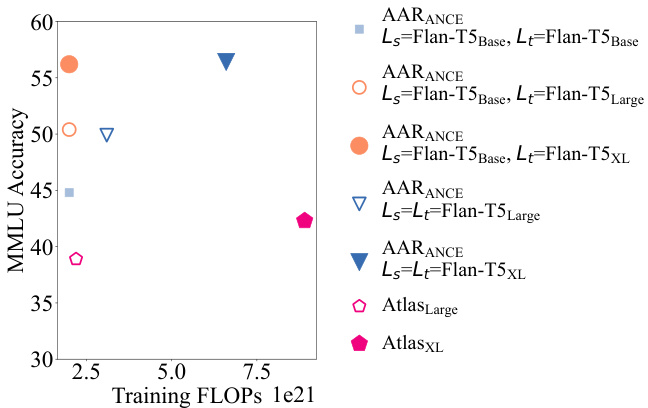
Figure 3: Training FLOPs of retrieval augmentation methods.
图 3: 检索增强方法的训练FLOPs。
5 Evaluation Results
5 评估结果
In this section, we discuss our main results on MMLU and PopQA datasets $(\S5.1)$ and conduct
在本节中,我们将讨论在MMLU和PopQA数据集上的主要结果 $(\S5.1)$ ,并进行
comprehensive studies about how $(\S5.2,\S5.3.$ $\S\S.4)$ and when $(\S5.5,\S5.6)$ AAR helps.
关于AAR如何 $(\S5.2,\S5.3.$ $\S\S.4)$ 以及何时 $(\S5.5,\S5.6)$ 发挥作用的全面研究。
5.1 Overall Performance
5.1 整体性能
Table 1 demonstrates that, with the assistance of a generic AAR, target LMs of different sizes and architectures can significantly outperform their standalone baselines in the zero-shot setting. Notably, AAR even improves powerful Instruct GP T by $2%$ on MMLU and by nearly $20%$ on PopQA. We hypothesize that the PopQA dataset mainly comprises long-tail questions and thus necessitates more augmentation information to attain high accuracy. AAR outperforms other augmentation methods like few-shot prompting and adaptive retrieval, as they may not offer as extensive evidence text as AAR does.
表 1: 结果表明,在通用AAR的辅助下,不同规模和架构的目标大语言模型在零样本设置中均能显著超越其独立基线水平。值得注意的是,AAR甚至将强大的InstructGPT在MMLU上的表现提升了$2%$,在PopQA上提升了近$20%$。我们推测PopQA数据集主要由长尾问题构成,因此需要更多增强信息以实现高准确率。AAR优于少样本提示和自适应检索等其他增强方法,因为这些方法可能无法提供像AAR那样广泛的证据文本。
Meanwhile, AAR is a highly efficient augmentation approach since it only relies on a small source
同时,AAR是一种高效的增强方法,因为它仅依赖于少量源
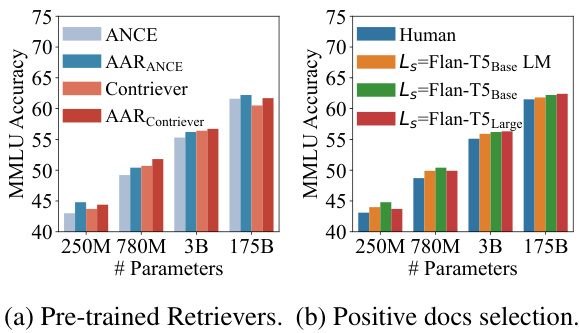
Figure 4: AAR’s performance when (a) using different pre-trained retrievers and (b) trained with different positive documents, using Flan-$\mathrm{T5}_ {\mathrm{Base}}$ (250M), Flan-$\mathrm{T5}_ {\mathrm{Large}}$ (780M), Flan-$\mathrm{{T}}5_{\mathrm{{XL}}}$ (3B), Instruct GP T (175B) as $L_{t}$ . The retriever in (b) is initialized from ANCE.
图 4: AAR在不同情况下的性能表现:(a) 使用不同预训练检索器时,(b) 使用不同正样本文档训练时。实验采用 Flan-$\mathrm{T5}_ {\mathrm{Base}}$ (250M)、Flan-$\mathrm{T}5_{\mathrm{Large}}$ (780M)、Flan-$\mathrm{{T}}5_{\mathrm{{XL}}}$ (3B) 和 Instruct GPT (175B) 作为 $L_{t}$。(b) 中的检索器基于ANCE初始化。
LM Flan-$\mathrm{T5_{Base}}$ (250M) to provide training signals and can generalize well to target LMs of larger capacities. Figure 3 illustrates that solely setting the source LM as the target LM (represented by the inverted triangles) does not significantly enhance the MMLU accuracy. However, it may triple the training budget required. Only using a small source LM is able to outperform the powerful Atlas by large margins with fewer training FLOPs.
LM Flan-$\mathrm{T5_{Base}}$ (250M) 来提供训练信号,并能很好地泛化到更大容量的目标大语言模型。图 3 表明,仅将源大语言模型设为目标大语言模型 (以倒三角形表示) 并不会显著提升 MMLU 准确率,反而可能使训练预算增加三倍。仅使用小型源大语言模型就能以更少的训练 FLOPs 大幅超越强大的 Atlas。
5.2 Ablation Study
5.2 消融研究
In this experiment, we conduct the ablation study of augmentation-adapted training and analyze model behaviors during the training process.
在本实验中,我们进行了数据增强适应训练 (augmentation-adapted training) 的消融研究,并分析了训练过程中的模型行为。
Figure 4a illustrates that augmentation-adapted training can bring additional improvements compared to the pre-trained retrievers. In general, ANCE benefits more from augmentation-adapted training than Contriever. This may be due to the fact that Contriever has been already intensively pre-trained on massive data augmentations as well as MS MARCO whereas ANCE is trained only on MS MARCO. We provide exact numbers in Table 7 and PopQA results in Figure 8, which yield similar observations as MMLU.
图 4a 表明,相较于预训练的检索器,适应增强训练能带来额外提升。总体而言,ANCE 从适应增强训练中获益多于 Contriever。这可能是因为 Contriever 已在海量数据增强和 MS MARCO 上进行了密集预训练,而 ANCE 仅基于 MS MARCO 训练。具体数值见表 7,PopQA 结果见图 8,其结论与 MMLU 实验结果一致。
In Figure 4b, we compare retrievers trained with different positive documents, including humanpreferred documents annotated by search users (the blue bar), LM-preferred documents obtained by the source LM (the orange bar), and their combinations (the green bar and the red bar). Since the retriever has been pre-trained on user-annotated MS MARCO, simply using human-preferred documents to train it may be meaningless and therefore performs the worst among all approaches. Only using LM-preferred documents demonstrates notable gains over only using human-preferred documents, and merging both human-preferred and LM-preferred documents (our main setup) further enhances the retriever’s performance. Finally, using Flan- $\mathrm{T5}_{\mathrm{Base}}$ as source LM yields better results compared to using Flan-T5Large when the target LMs are relatively small. However, as the target LM’s size increases, both approaches achieve comparable performance. Hence, our choice to utilize a small source LM in the augmentation-adapted training is reasonable and effective.
在图4b中,我们比较了使用不同正向文档训练的检索器,包括搜索用户标注的人类偏好文档(蓝色柱)、源大语言模型获得的模型偏好文档(橙色柱)及其组合(绿色柱和红色柱)。由于检索器已在用户标注的MS MARCO数据集上进行了预训练,仅使用人类偏好文档进行训练可能没有意义,因此在所有方法中表现最差。仅使用模型偏好文档相比仅使用人类偏好文档显示出显著提升,而合并人类偏好和模型偏好文档(我们的主要设置)则进一步提高了检索器性能。最后,当目标大语言模型较小时,使用Flan-$\mathrm{T5}_ {\mathrm{Base}}$作为源模型比使用Flan-T5Large获得更好结果;但随着目标模型规模增大,两种方法达到相当性能。因此,我们在适应增强训练中选择使用小型源模型是合理且有效的。
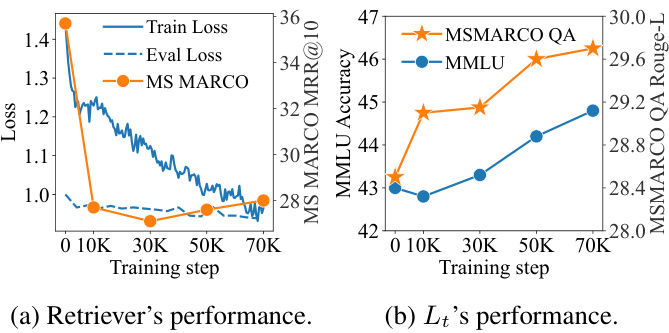
Figure 5: AAR’s training process. (a) exhibits the retriever’s (ANCE) performance on MS MARCO. (b) presents the $L_{t}$ ’s (Flan $\cdot\mathrm{T}5_{\mathrm{Base}}$ ) performance on MSMARCO QA and MMLU.
图 5: AAR的训练过程。(a)展示了检索器(ANCE)在MS MARCO上的性能。(b)展示了$L_{t}$(Flan $\cdot\mathrm{T}5_{\mathrm{Base}}$)在MSMARCO QA和MMLU上的性能。
Figure 5a and Figure 5b plot the retriever’s and LM’s performance during augmentation-adapted training, respectively. At the beginning of the training, the retriever’s $\mathrm{MRR}@10$ on the MS MARCO drops dramatically, indicating a large distribution gap between human-preferred and LM-preferred documents. As the retriever’s train and dev loss continually decline, the retrieval-augmented LM gradually performs better on MSMARCO QA and eventually, on MMLU. This result implies that LMs on different task may share common preferences, making AAR generalize well from single source task to heterogeneous target tasks.
图 5a 和图 5b 分别展示了增强适应训练过程中检索器和语言模型的性能表现。训练初期,检索器在 MS MARCO 数据集上的 $\mathrm{MRR}@10$ 指标急剧下降,表明人类偏好文档与语言模型偏好文档之间存在显著分布差异。随着检索器训练损失和验证损失持续降低,检索增强的语言模型在 MSMARCO QA 任务上的表现逐步提升,并最终在 MMLU 任务中取得进步。这一结果表明,不同任务的语言模型可能具有共同偏好,使得自适应增强检索 (AAR) 能够从单一源任务良好泛化到异构目标任务。
5.3 Analysis of LM-preferred Documents
5.3 大语言模型偏好文档分析
We highlight the necessity of adapting existing retrievers to LMs by comparing the preferred documents between search users and LMs. In general, we discover that LM-preferred documents can assist LM from alternative perspectives rather than the full information favored by search users.
我们通过比较搜索用户和大语言模型偏好的文档,强调了调整现有检索器以适应大语言模型的必要性。总体而言,我们发现大语言模型偏好的文档能从不同于搜索用户青睐的完整信息的替代视角为其提供帮助。
First, we define the set overlap $O$ between two positive documents set $D_{1}^{+}$ and $D_{2}^{+}$ as:
首先,我们定义两个正文档集 $D_{1}^{+}$ 和 $D_{2}^{+}$ 之间的集合重叠度 $O$ 为:
$$
O=\frac{D_{1}^{+}\cap D_{2}^{+}}{D_{1}^{+}\cup D_{2}^{+}}.
$$
$$
O=\frac{D_{1}^{+}\cap D_{2}^{+}}{D_{1}^{+}\cup D_{2}^{+}}.
$$
As illustrated in Figure 6a, the set overlaps of the positive document sets annotated by human users $(D^{h+})$ and LMs (Top $-K_{S_{i}^{a},D^{a}})$ are quite low (near $13%)$ , demonstrating their distinct tendencies in selecting valuable documents. On the contrary, the overlaps between different LMs are relatively high (over $55%$ ). This evidence provides a strong rationale for the generalization ability of AAR since LMs with different sizes tend to annotate similar positive documents. Furthermore, LMs whose sizes are closer generally possess higher overlaps. This implies a better generalization ability of the AAR to the LMs whose capacity is near the source LM. The findings further validate the results illustrated in Figure 4b.
如图6a所示,人工标注的正文档集$(D^{h+})$与大语言模型标注的Top$-K_{S_{i}^{a},D^{a}}$集合重叠率极低(约$13%$),表明两者在筛选有价值文档时存在显著差异。相反,不同大语言模型间的标注重叠率较高(超过$55%$)。这一现象为AAR的泛化能力提供了有力依据,因为不同规模的模型倾向于标注相似的正文档。此外,模型规模越接近,其标注重叠率通常越高,说明AAR对与源模型容量相近的大语言模型具有更好的泛化能力。该发现进一步验证了图4b所示的结果。
Table 2: Cases study on MSMARCO QA dataset. We show Top-1 document annotated by human users and FiDAt scores. Red texts are the gold answer spans.
| Question | Human-preferred Document | LM-preferred Document |
| what happens if you miss your cruise ship | If you domiss the ship,gointo the cruiseterminal andtalkwiththeport agents, who are in contact with both shipboardandshoresidepersonnel They can help you decide the best way to meet your ... | The cruise line is not financially respon- sible for getting passengers to the next port if they miss the ship.Your travel to the subsequent port, or home, is on your dime, as are any necessary hotel stays and meals... |
| what is annexation? | Annexation isan activityinwhichtwo things arejoined together,usuallywith a subordinateorlesser thingbeingat- tached to a larger thing. In strict legal terms, annexation simply involves... | Annexation (Latin ad,to,and nexus, joining) is the administrative action and concept in international law relating to theforcibletransitionof onestate's ter- ritory by another state. It is generally held to be an illegal act.. |
表 2: MSMARCO QA数据集案例研究。展示人工标注的Top-1文档及FiDAt评分,红色文本为黄金答案片段。
| 问题 | 人工偏好文档 | 大语言模型偏好文档 |
|---|---|---|
| 错过邮轮会怎样 | 若错过登船,请前往邮轮码头与港口代理沟通,他们与船上及岸上人员保持联系,可协助制定最佳方案... | 邮轮公司不承担乘客因误船产生的后续港口或返程费用,包括必要住宿及餐饮开支... |
| 什么是领土兼并 | 兼并指将两个事物结合的活动,通常较小部分依附于较大部分。严格法律意义上,兼并仅涉及... | 领土兼并(拉丁语ad表示"至",nexus表示"连接")是国际法中关于一国领土被另一国强制转移的行政行为概念,通常被视为非法行为... |
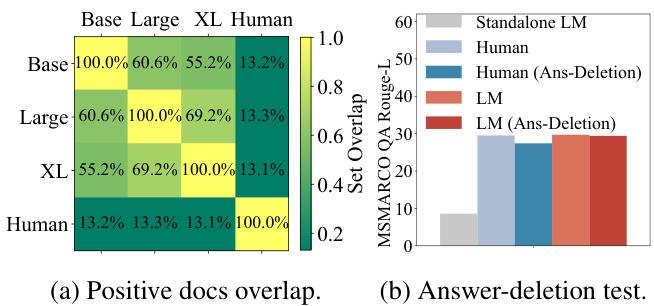
Figure 6: Analysis of LM-preferred documents. (a) shows the overlaps of positive document sets, where used LMs are Flan-T5 series. (b) presents the answerdeletion experiments on the MSMARCO QA dataset. The retriever is initialized from ANCE.
图 6: LM偏好文档分析。(a) 展示了正文档集的重叠情况,使用的LM为Flan-T5系列。(b) 呈现了在MSMARCO QA数据集上进行的答案删除实验。检索器基于ANCE初始化。
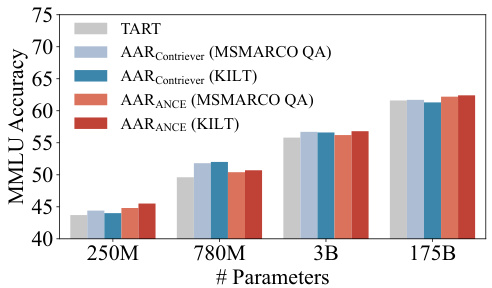
Figure 7: Comparison between single-task (MSMARCO QA) and multi-task (KILT) trained AAR. TART (Asai et al., 2022) is a multi-task instructionfinetuned retriever that has not been finetuned with LMpreferred signals.
图 7: 单任务 (MSMARCO QA) 与多任务 (KILT) 训练的 AAR 对比。TART (Asai et al., 2022) 是一个未经 LM 偏好信号微调的多任务指令微调检索器。
To give an in-depth analysis of how humanpreferred and LM-preferred documents differ, we show two representative cases sampled from the MSMARCO QA in Table 2. We observe that the human-preferred document can always present the gold answer at the beginning of the text, while the LM-preferred document may not contain the exact answer. However, an LM-preferred document can (1) deliver a new perspective to answer the given question, e.g., “the cruise line’s resp on sibi lity if you miss your cruise ship” and (2) give a specific explanation instead of an abstract definition, e.g., “forcible transition of one state’s territory by another state”, These characteristics differ from search users who want the full information and can further assist LMs in knowledge-based reasoning.
为了深入分析人类偏好和大语言模型偏好的文档差异,我们从MSMARCO QA数据集中选取了两个典型案例展示在表2中。研究发现,人类偏好的文档总是能在开头就呈现正确答案,而大语言模型偏好的文档可能不包含确切答案。但后者具有以下优势:(1) 能提供回答问题的新视角,例如"邮轮公司对乘客误船应承担的责任";(2) 能给出具体解释而非抽象定义,例如"一国对另一国领土的强制性占领"。这些特点不同于搜索用户追求完整信息的需求,但能辅助大语言模型进行知识推理。
We further examine the unique characteristics of LM-preferred documents through the answerdeletion test (i.e., deleting the exact answer span from the retrieved documents). As shown in Figure 6b, the retriever trained by either humanpreferred (i.e., human-preferred retriever) or LMpreferred documents (i.e., LM-preferred retriever) can help LM answer the given question. Nevertheless, after the answer-deletion, the performance of LM with the human-preferred retriever declines more significantly than with the LM-preferred retriever. Despite having fewer exact match answers ( $0.6%$ for LM-preferred documents vs. $13.0%$ for human-preferred documents), LM-preferred documents provide helpful information from alternative perspectives. Therefore, adapting retrievers with LM-preferred documents can in turn make retrievalaugmented LM perform better.
我们通过答案删除测试(即从检索文档中删除精确答案片段)进一步研究了LM偏好文档的独特特征。如图6b所示,无论是通过人类偏好(即人类偏好检索器)还是LM偏好文档(即LM偏好检索器)训练的检索器,都能帮助LM回答给定问题。然而,在答案删除后,使用人类偏好检索器的LM性能下降幅度明显大于使用LM偏好检索器的情况。尽管LM偏好文档的精确匹配答案较少(LM偏好文档为0.6%,人类偏好文档为13.0%),但它们能从其他角度提供有用信息。因此,使用LM偏好文档调整检索器反而能使检索增强的LM表现更好。
Table 3: Ablation of the retrieval corpus, with Flan $\mathrm{T}5_{\mathrm{Base}}$ as LM and AARANCE as retriever.
| Corpora | MMLU | PopQA All | ||||
| All | Hum. | Soc.Sci. | STEM | Other | ||
| MSMARCO | 44.8 | 42.2 | 46.4 | 39.0 | 53.2 | 13.6 |
| KILT-Wikipedia | 42.6 | 42.5 | 45.9 | 34.3 | 50.5 | 37.7 |
| StandaloneLM | 36.1 | 40.4 | 39.8 | 27.0 | 40.6 | 8.8 |
表 3: 检索语料库的消融实验,使用 Flan $\mathrm{T}5_{\mathrm{Base}}$ 作为语言模型 (LM) 和 AARANCE 作为检索器。
| Corpora | MMLU All | Hum. | Soc.Sci. | STEM | Other | PopQA All |
|---|---|---|---|---|---|---|
| MSMARCO | 44.8 | 42.2 | 46.4 | 39.0 | 53.2 | 13.6 |
| KILT-Wikipedia | 42.6 | 42.5 | 45.9 | 34.3 | 50.5 | 37.7 |
| StandaloneLM | 36.1 | 40.4 | 39.8 | 27.0 | 40.6 | 8.8 |
5.4 Multi-task Training of AAR
5.4 AAR的多任务训练
In this section, we explore if the multi-task training of AAR can endow the retriever with better generalization to the target task. Specifically, we choose KILT (Petroni et al.) as our multi-task data source, which consists of 5 categories (Fact Checking, Entity Linking, Slot Filling, Open Domain QA, and Dialogue). We take one representative subtask per category to form a mixture of multiple source tasks.
在本节中,我们探讨AAR的多任务训练能否使检索器对目标任务具有更好的泛化能力。具体而言,我们选择KILT (Petroni等人)作为多任务数据源,它包含5个类别(事实核查、实体链接、槽填充、开放域问答和对话)。我们从每个类别中选取一个代表性子任务,组成多源任务的混合体。
Figure 7 illustrates that ANCE trained with multi-task KILT can consistently outperform the single-task MSMARCO QA, proving the better generalization ability brought by multi-task augmentation-adapted training. It is possible that LMs may vary slightly in preferred documents for different tasks and AAR can switch more smoothly to the target task with the help of multi-task training. Contriever does not benefit greatly from multitask training. We conjecture that this is because Contriever has been pre-trained with multiple formats of data augmentations and thus generalizes better to new data distribution than ANCE. Interestingly, multi-task instruction-finetuned retriever TART (Asai et al., 2022) has an overall worse performance compared to AAR, highlighting the benefits of having LM-preferred documents during the multi-task training. A more detailed analysis about the selection of source tasks is in Appendix B.
图 7: 采用多任务KILT训练的ANCE模型持续优于单任务MSMARCO QA,证明多任务增强适应性训练能带来更好的泛化能力。这可能是因为语言模型对不同任务的偏好文档存在细微差异,而AAR通过多任务训练能更顺畅地切换至目标任务。Contriever未能从多任务训练中获得显著提升,我们推测这是由于Contriever已通过多种数据增强形式进行预训练,因此比ANCE对新数据分布具有更好的泛化能力。值得注意的是,经过多任务指令微调的检索器TART (Asai et al., 2022) 整体表现逊于AAR,这突显了在多任务训练期间采用语言模型偏好文档的优势。关于源任务选择的更详细分析见附录B。
5.5 Effect of Retrieval Corpus
5.5 检索语料库的影响
Table 3 demonstrates that regardless of the retrieval corpus, AAR results in consistent and substantial performance gains over the standalone LM.
表 3: 表明无论检索语料库如何,AAR都能比独立大语言模型带来持续且显著的性能提升。
On MMLU, using MS MARCO as the retrieval corpus improves the LM more compared to KILTWikipedia. We hypothesize that the retriever has been trained with MS MARCO corpus and thus holds better retrieval performance on it.
在MMLU任务中,使用MS MARCO作为检索语料相比KILTWikipedia更能提升语言模型性能。我们推测这是由于检索器在MS MARCO语料上训练过,因此对其具有更好的检索表现。
Table 4: Results of OPT and GPT-neo. We use their 1.3B version. The score marked as bold means the best performance in the zero-shot setting.
| Settings | Methods | MMLU All | PopQA All |
| Few-shot | OPT (Zhang et al.,2022) GPT-neo(Black etal.,2021) OPT | 26.0 28.7 | 12.3 11.3 12.0 |
| Zero-shot | GPT-neo OPTGenRead GPT-neoGenRead OPT w/ AARContriever (Ours) GPT-neo w/AARContriever (Ours) OPT w/ AARANCE (Ours) | 22.7 25.3 22.3 24.4 23.2 25.2 23.7 26.6 | 9.9 12.2 11.9 29.1 27.8 32.9 |
表 4: OPT 和 GPT-neo 的结果。我们使用它们的 1.3B 版本。加粗分数表示零样本设置下的最佳性能。
| Settings | Methods | MMLU All | PopQA All |
|---|---|---|---|
| Few-shot | OPT (Zhang et al., 2022) GPT-neo (Black et al., 2021) OPT | 26.0 28.7 | 12.3 11.3 12.0 |
| Zero-shot | GPT-neo OPTGenRead GPT-neoGenRead OPT w/ AARContriever (Ours) GPT-neo w/AARContriever (Ours) OPT w/ AARANCE (Ours) | 22.7 25.3 22.3 24.4 23.2 2 |
